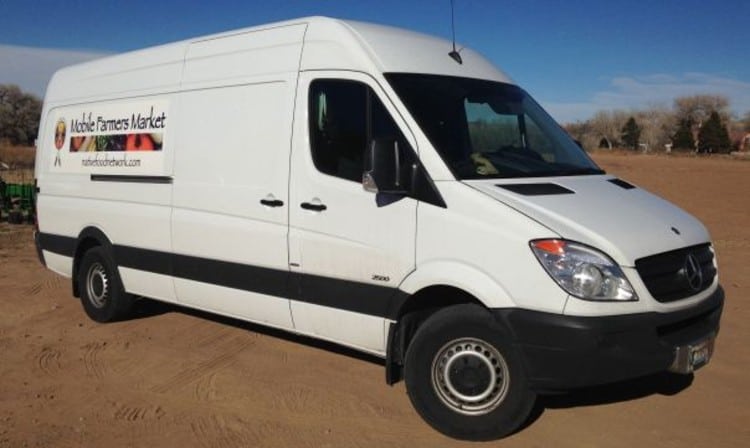Motivated by a need to optimize the distribution of traditional foods, the Intertribal Agricultural Council (IAC) began a nationwide Tribal Trade Routes Roadtrip to raise awareness about the value of traditional foods.
The Mobile Farmers Market tours the country in a fuel-efficient cargo van with products from various tribes nationwide in tow. Their aim is to improve the access that tribal and non-tribal communities have to healthy traditional foods and to provide technical support for tribal communities that express interest in starting local farmers markets. The Mobile Farmers Market began their journey in the Great Lakes region and so far has stopped in regions of Washington, California, Arizona, Oklahoma, and Louisiana.
“We already carried some products from other places and thought it would be great opportunity to take products from our region and pick up products from other regions and add it into our inventory and, along the way, tell the story of different native food products,” says Dan Cornelius, General Manager of the Mobile Farmers Market.
The IAC was founded in 1987 with the mission of promoting the conservation, development, and sustainable use of tribal agricultural resources and has since developed working relationships with tribes nationwide and U.S. federal agencies.
The IAC helms a number of initiatives with the support of the U.S. Department of Agriculture (USDA). In collaboration with the USDA Office of Tribal Relations, the IAC has established technical assistance centers that aim to increase the access and use of USDA programs and services by Native American producers. The IAC also partners with the USDA Foreign Agricultural Service to run the American Indian Foods (AIF) program, a platform for Native American food businesses to share their products with the world. Moreover, the IAC promotes the “Made/Produced by American Indians” trademark that identifies American Indian products genuinely produced by federally-recognized tribes.
The Mobile Farmers Market welcomes any surplus traditional foods from producers they encounter along the way. “People have always traded—the exchange has always happened, but what we’re helping to do is to bring a more coordinated approach, so when someone is interested, they know what’s out there. When some wants to place an order, they can come to us,” says Cornelius.
Cornelius explains that improving the access that tribal producers have to markets has the potential to increase tribal economic development in a way that is both respectful to the environment and to tribal culture. At present, tribal families produce traditional foods primarily at subsistence levels, though historically, tribes in the Midwestern region have thrived on robust levels of food production.
“Maple trees run from anywhere between a week to three weeks or a month. The trees will flow with sap, which you boil and turn into syrup,” says Cornelius. “In 1866, the Menominee produced 75,000 pounds of syrup a year. It takes 40 to 50 gallons of sap to get one gallon of syrup […] That means that 3.5 million gallons of sap went into producing a product that was going to market in 1866, and this was over one hundred years ago.”
The Mobile Farmers Market aims to mobilize tribal food producers interested in expanding market access to their products, which the IAC will help distribute in larger quantities by partnering with interested food retailers. At present, the IAC is adding new components to their website that will permit individuals to purchase traditional foods directly through the site.
“Eighty percent of the USDA’s budget is going to nutrition programs,” says Cornelius. “This is a way of providing that access to SNAP recipients, opening up a whole realm of resources for low-income individuals and households to purchase traditional foods.”
The Mobile Farmers Market is also looking to develop partnerships with existing farmers markets and community organizations interested in offering complimentary services like cooking classes. Its ultimate mission is to strengthen the regional Native American food economy and expand tribal producers’ access to local and national markets.
“The value of this effort is tying everything together and finding a way to feed our community but at the same time promoting sustainable business models—helping people to make a living in a sustainable manner,” says Cornelius.






